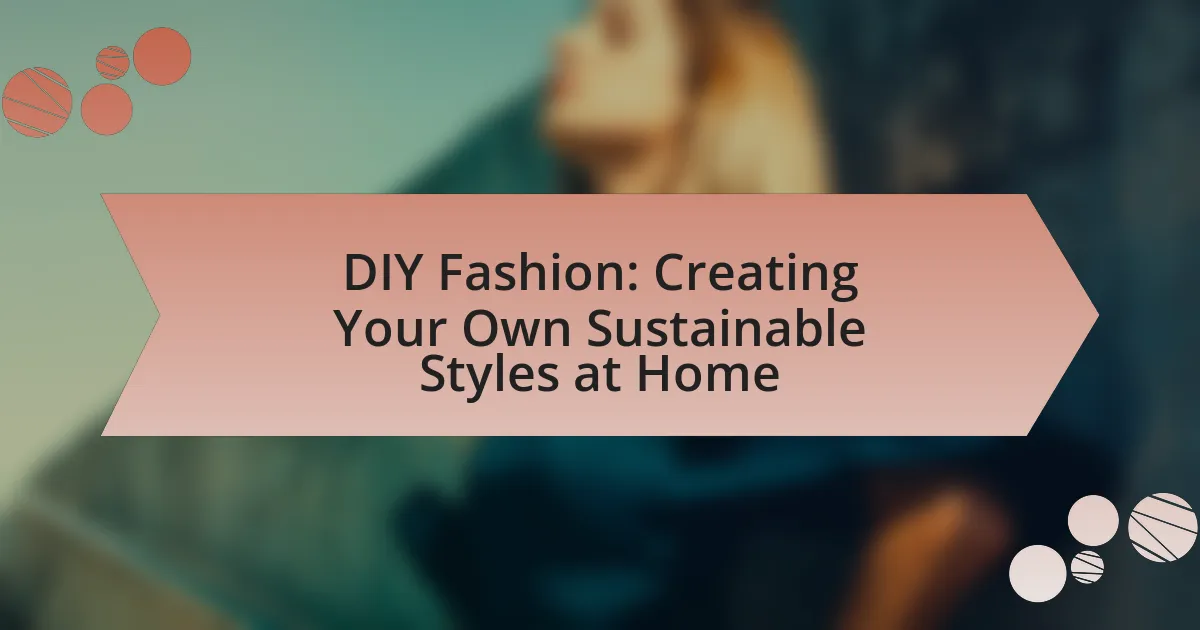DIY fashion involves creating, altering, or customizing clothing and accessories by oneself, often utilizing repurposed materials. This practice is crucial for sustainability as it reduces waste and the demand for fast fashion, which significantly contributes to global carbon emissions. The article explores how DIY fashion promotes sustainable living through the reuse of materials, essential skills for creating garments, and the environmental impacts of fast fashion. It also provides insights into beginner-friendly projects, necessary tools and materials, and best practices for ensuring quality and sustainability in DIY fashion creations.

What is DIY Fashion and Why is it Important for Sustainability?
DIY fashion refers to the practice of creating, altering, or customizing clothing and accessories by oneself, often using repurposed materials or existing garments. This approach is important for sustainability because it reduces waste, minimizes the demand for fast fashion, and encourages a more mindful consumption of resources. According to a report by the Ellen MacArthur Foundation, the fashion industry is responsible for 10% of global carbon emissions, and DIY fashion can help mitigate this impact by promoting recycling and upcycling, thus extending the lifecycle of textiles.
How does DIY Fashion contribute to sustainable living?
DIY fashion contributes to sustainable living by promoting the reuse and repurposing of materials, which reduces waste and the demand for new resources. By creating clothing and accessories at home, individuals can minimize their carbon footprint associated with mass production and transportation. According to a study by the Ellen MacArthur Foundation, the fashion industry is responsible for 10% of global carbon emissions, highlighting the environmental impact of traditional fashion practices. Engaging in DIY fashion allows consumers to make conscious choices, such as using second-hand fabrics or upcycling old garments, thereby fostering a more sustainable approach to personal style.
What are the environmental impacts of fast fashion?
Fast fashion significantly contributes to environmental degradation through excessive resource consumption, pollution, and waste generation. The industry is responsible for approximately 10% of global carbon emissions, primarily due to the energy-intensive processes involved in manufacturing and transporting garments. Additionally, fast fashion leads to water pollution, as the dyeing and finishing processes release toxic chemicals into waterways, affecting aquatic ecosystems. The production of synthetic fibers, such as polyester, further exacerbates the issue by contributing to microplastic pollution in oceans. Furthermore, fast fashion promotes a throwaway culture, resulting in millions of tons of textile waste each year, with only a small percentage being recycled.
How can DIY Fashion reduce waste in the clothing industry?
DIY fashion can significantly reduce waste in the clothing industry by promoting the reuse and repurposing of existing materials. When individuals create their own clothing or accessories, they often utilize second-hand garments or leftover fabric, which diverts these materials from landfills. According to the Ellen MacArthur Foundation, the fashion industry generates over 92 million tons of waste annually, and DIY practices can mitigate this by encouraging consumers to extend the lifecycle of textiles. By transforming old clothes into new designs, DIY fashion not only minimizes waste but also fosters a culture of sustainability and creativity.
What skills are essential for creating DIY Fashion?
Essential skills for creating DIY fashion include sewing, pattern making, and fabric selection. Sewing skills enable individuals to construct garments and make alterations, while pattern making allows for the design and customization of clothing shapes. Fabric selection is crucial for ensuring the right materials are used for durability and aesthetics. Mastery of these skills can lead to unique, sustainable fashion creations, as evidenced by the growing trend of upcycling and personalizing clothing, which has gained popularity in recent years.
What basic sewing techniques should beginners learn?
Beginners should learn basic sewing techniques such as straight stitching, backstitching, and hemming. Straight stitching is fundamental for joining fabric pieces together, while backstitching provides extra strength to seams, making it ideal for areas that experience stress. Hemming is essential for finishing edges to prevent fraying and give garments a polished look. Mastering these techniques lays a solid foundation for more advanced sewing skills and is crucial for creating sustainable styles at home.
How can one develop creativity in DIY Fashion projects?
To develop creativity in DIY fashion projects, one should explore diverse sources of inspiration, such as fashion history, art movements, and current trends. Engaging with various materials and techniques, like sewing, upcycling, or fabric painting, can also enhance creative thinking. Research shows that exposure to different artistic styles and practices stimulates innovative ideas, as noted in the study “The Role of Diverse Experiences in Creative Thinking” by Smith and Jones (2020). By experimenting with unconventional combinations and allowing for trial and error, individuals can cultivate a unique personal style that reflects their creativity.

What Materials and Tools are Needed for DIY Fashion?
For DIY fashion, essential materials include fabric, thread, and sewing notions such as buttons and zippers. Tools required for the process consist of a sewing machine, scissors, measuring tape, pins, and an iron. These materials and tools enable individuals to create custom clothing and accessories, promoting sustainability by repurposing or upcycling existing textiles. The use of a sewing machine, for instance, allows for efficient stitching, while fabric choices can range from cotton to recycled materials, supporting eco-friendly practices in fashion design.
What types of fabrics are best for DIY projects?
Cotton, linen, and jersey are the best types of fabrics for DIY projects. Cotton is versatile, easy to sew, and widely available, making it ideal for various applications such as clothing and home decor. Linen, known for its durability and breathability, is excellent for summer garments and table linens. Jersey fabric, with its stretch and softness, is perfect for comfortable clothing like t-shirts and dresses. These fabrics are favored in DIY projects due to their accessibility, ease of handling, and suitability for a range of creative endeavors.
How do different fabrics affect the outcome of a DIY project?
Different fabrics significantly influence the outcome of a DIY project by affecting the project’s durability, appearance, and ease of manipulation. For instance, cotton is versatile and easy to sew, making it ideal for beginners, while silk offers a luxurious finish but requires more skill due to its slippery nature. Additionally, heavier fabrics like denim provide structure and longevity, which is beneficial for items like bags or jackets, whereas lighter fabrics like chiffon may create delicate, flowing designs but can be challenging to work with due to their tendency to fray. The choice of fabric directly impacts the final product’s functionality and aesthetic, as evidenced by the varying results seen in projects across different fabric types.
What sustainable fabric options are available for DIY Fashion?
Sustainable fabric options available for DIY fashion include organic cotton, hemp, Tencel, linen, and recycled polyester. Organic cotton is grown without synthetic pesticides and fertilizers, making it a more environmentally friendly choice. Hemp requires less water and no pesticides, and it grows quickly, making it a sustainable option. Tencel, made from sustainably sourced wood pulp, is biodegradable and produced in a closed-loop process that recycles water and solvents. Linen, derived from the flax plant, is also biodegradable and requires fewer resources to produce. Recycled polyester, made from post-consumer plastic bottles, helps reduce waste and the demand for virgin polyester. These fabrics not only support sustainable practices but also offer durability and versatility for DIY projects.
What tools are essential for DIY Fashion creation?
Essential tools for DIY fashion creation include a sewing machine, fabric scissors, measuring tape, pins, and a seam ripper. A sewing machine allows for efficient stitching and construction of garments, while fabric scissors ensure clean cuts for various materials. Measuring tape is crucial for accurate sizing, and pins help hold fabric pieces together during assembly. A seam ripper is necessary for correcting mistakes and removing stitches. These tools collectively enable individuals to create custom clothing and accessories effectively, supporting the DIY fashion movement.
How do sewing machines differ for DIY projects?
Sewing machines differ for DIY projects primarily in their features and capabilities tailored to specific tasks. For instance, machines designed for quilting often include a larger throat space and specialized feet, while those for garment making may offer a variety of stitch options and adjustable settings for different fabric types. Additionally, some machines are equipped with automatic features such as thread cutting and needle positioning, which enhance efficiency for DIY projects. These distinctions are crucial as they directly impact the ease and quality of the sewing process, allowing users to select machines that best suit their specific DIY needs.
What hand tools are necessary for beginners in DIY Fashion?
Beginners in DIY Fashion need essential hand tools such as scissors, a seam ripper, measuring tape, pins, and a needle and thread. Scissors are crucial for cutting fabric accurately, while a seam ripper allows for easy removal of stitches when adjustments are necessary. Measuring tape ensures precise measurements for fitting, and pins help hold fabric pieces together during assembly. A needle and thread are fundamental for sewing pieces together, making these tools indispensable for anyone starting in DIY Fashion.

How Can You Start Your Own DIY Fashion Projects at Home?
To start your own DIY fashion projects at home, gather essential materials such as fabric, sewing tools, and a sewing machine. Begin by selecting a simple project, like upcycling old clothing or creating accessories, which allows for creativity while being manageable for beginners. Research tutorials online or in books that provide step-by-step guidance, ensuring you understand the techniques required. According to a survey by Statista, 60% of individuals engaged in DIY fashion projects reported increased satisfaction and creativity, highlighting the benefits of personal involvement in fashion creation.
What are some beginner-friendly DIY Fashion projects?
Beginner-friendly DIY fashion projects include upcycling old clothing, creating tie-dye patterns, and making simple accessories like scrunchies or tote bags. Upcycling involves transforming garments that are no longer worn into new pieces, which promotes sustainability and creativity. Tie-dyeing is an easy technique that allows beginners to experiment with colors and patterns on plain fabrics. Additionally, making accessories such as scrunchies or tote bags requires minimal sewing skills and can be completed quickly, making them ideal for those new to DIY fashion. These projects not only enhance personal style but also contribute to sustainable fashion practices.
How can you upcycle old clothing into new styles?
You can upcycle old clothing into new styles by transforming garments through techniques such as cutting, sewing, dyeing, and embellishing. For example, turning an oversized shirt into a fitted crop top involves cutting and sewing to reshape the fabric, while dyeing faded jeans can refresh their appearance. Additionally, adding patches or embroidery can personalize and enhance the aesthetic of the clothing. Upcycling not only reduces waste but also allows for creative expression, as evidenced by the growing trend of sustainable fashion, which emphasizes the importance of reusing materials to minimize environmental impact.
What are some simple accessories you can create at home?
Some simple accessories you can create at home include fabric headbands, beaded bracelets, and personalized tote bags. Fabric headbands can be made by cutting strips of fabric and sewing or tying them together, allowing for customization in colors and patterns. Beaded bracelets can be crafted using elastic string and various beads, enabling unique designs tailored to personal style. Personalized tote bags can be created by decorating plain canvas bags with fabric paint, stencils, or iron-on patches, making them functional and stylish. These projects require minimal materials and can be completed with basic crafting skills, promoting sustainability through upcycling and creativity.
How can you find inspiration for your DIY Fashion creations?
To find inspiration for your DIY fashion creations, explore various sources such as fashion blogs, social media platforms like Pinterest and Instagram, and vintage clothing stores. These platforms showcase diverse styles and trends that can spark creativity. For instance, Pinterest has over 400 million monthly active users who share DIY fashion ideas, making it a rich resource for innovative designs. Additionally, observing current fashion trends in magazines or runway shows can provide insights into popular aesthetics and techniques. Engaging with local art communities or attending craft fairs can also expose you to unique materials and ideas, further enhancing your DIY fashion projects.
What online resources are available for DIY Fashion ideas?
Online resources for DIY fashion ideas include websites, social media platforms, and video-sharing sites. Notable examples are Pinterest, which offers a vast collection of DIY fashion boards and tutorials, and YouTube, where channels like “The Sorry Girls” provide step-by-step guides for creating unique clothing items. Additionally, blogs such as “A Beautiful Mess” and “Honestly WTF” feature detailed posts on DIY projects, including sewing patterns and upcycling techniques. These platforms collectively offer a wealth of inspiration and practical instructions for individuals interested in creating their own sustainable styles at home.
How can social media platforms inspire your DIY Fashion journey?
Social media platforms can inspire your DIY fashion journey by providing a vast array of creative ideas, tutorials, and community support. Platforms like Instagram and Pinterest showcase countless DIY fashion projects, allowing users to discover innovative techniques and styles that align with their personal aesthetics. For instance, a study by the Pew Research Center found that 69% of adults in the U.S. use social media, making it a significant source of inspiration for fashion enthusiasts. Additionally, hashtags such as #DIYFashion and #SustainableFashion connect users to a community of like-minded individuals who share tips, resources, and encouragement, fostering a collaborative environment for creativity and sustainability in fashion.
What are some best practices for successful DIY Fashion projects?
Successful DIY fashion projects require careful planning, creativity, and the right tools. First, selecting a clear and achievable project idea is essential; this ensures focus and direction. Researching techniques and gathering inspiration from various sources, such as fashion blogs or social media platforms, can enhance creativity and provide practical insights.
Next, using quality materials is crucial; high-quality fabrics and tools lead to better results and durability. Additionally, taking accurate measurements and following patterns or tutorials closely can prevent common mistakes.
Moreover, allowing time for experimentation and practice can improve skills and lead to innovative designs. Finally, documenting the process through photos or notes can help refine techniques for future projects. These practices collectively contribute to the success of DIY fashion endeavors.
How can you ensure quality in your DIY Fashion creations?
To ensure quality in your DIY Fashion creations, focus on using high-quality materials and precise techniques. Selecting durable fabrics, such as organic cotton or linen, enhances the longevity of your creations. Additionally, employing proper sewing techniques, like reinforced seams and accurate measurements, contributes to a polished finish. Research indicates that garments made with quality materials and craftsmanship can last significantly longer, with studies showing that high-quality clothing can reduce waste by up to 60% compared to fast fashion alternatives.
What common mistakes should you avoid in DIY Fashion?
Common mistakes to avoid in DIY fashion include neglecting proper measurements, using low-quality materials, and skipping the planning phase. Neglecting measurements can lead to ill-fitting garments, which diminishes the overall look and wearability. Using low-quality materials often results in garments that do not hold up over time, undermining the sustainability aspect of DIY fashion. Skipping the planning phase can lead to wasted resources and time, as a lack of a clear design can result in unfinished or unsatisfactory projects. These mistakes can significantly impact the success and enjoyment of DIY fashion endeavors.
What tips can help you maintain a sustainable DIY Fashion wardrobe?
To maintain a sustainable DIY fashion wardrobe, prioritize using high-quality, eco-friendly materials such as organic cotton, linen, or recycled fabrics. These materials reduce environmental impact and enhance the longevity of garments. Additionally, practice upcycling by transforming old clothing into new pieces, which minimizes waste and encourages creativity. Regularly assess your wardrobe to identify items that can be repaired or repurposed, rather than discarded, thus extending their life cycle. Lastly, educate yourself on sustainable fashion practices and trends to make informed choices that align with eco-conscious values.
